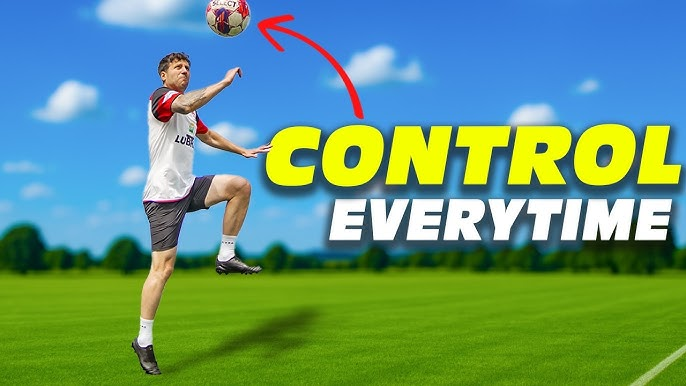A player’s first touch is a crucial moment that can determine the flow of the game. It’s the initial connection with the ball, setting up opportunities for dribbling, passing, or shooting. Developing control, precision, and awareness in these first moments allows athletes to react faster, make smarter decisions, and maintain possession under pressure, ultimately enhancing their effectiveness and confidence on the field.
Contents
Understanding The Importance Of First Touch
In football, the first touch is the foundation of effective ball control and overall gameplay. A precise first touch allows a player to maintain possession, create space, and set up the next move seamlessly. Without it, even the most talented players can struggle to execute passes, dribbles, or shots under pressure.
The quality of a first touch directly influences the pace of the game. When a player receives the ball cleanly, they can transition quickly between defense and attack, making it harder for opponents to anticipate actions. Conversely, a poor first touch can result in lost possession, missed opportunities, or a breakdown in team coordination. Developing this skill requires not only technical ability but also awareness of the surrounding environment, including the positions of teammates and opponents.
Beyond technical benefits, a strong first touch builds confidence on the field. Players who trust their ability to control the ball immediately after receiving it are more willing to attempt creative plays, take on defenders, and contribute effectively to the team’s strategy. This confidence also reduces hesitation, which can be crucial in fast-paced matches where split-second decisions matter.
Practicing first touch can be enhanced through interactive methods, such as watching and playing free online soccer with XoilacTV. Such platforms allow players to simulate in-game situations, helping them understand ball dynamics and improve reaction time in a controlled environment. By prioritizing first touch mastery, players at all levels can elevate their performance, control the flow of the game, and make a more significant impact during matches.
Key Techniques To Master First Touch
Mastering the first touch in football requires consistent practice, awareness, and understanding of different ball-handling techniques. A good first touch sets up every pass, dribble, or shot, and can significantly influence a player’s performance on the field. Here are the key techniques every player should focus on:

Using Different Parts Of The Foot
A versatile first touch depends on knowing how to use various parts of the foot effectively. The inside of the foot is ideal for short, controlled passes, while the outside can help redirect the ball quickly and change direction. The instep or laces are best for controlling long passes and launching forward plays. Developing the ability to switch between these techniques allows players to adapt to different situations during a match. Consistent practice ensures the touch is soft yet precise, reducing the likelihood of losing possession.
Body Positioning And Balance
Proper body positioning is critical for an effective first touch. A slightly bent knee, relaxed upper body, and low center of gravity help absorb the ball’s momentum and maintain control. Facing the ball at the right angle allows players to anticipate the next move, whether it’s passing, dribbling, or shooting. Good balance also enables quicker reactions, essential when under pressure from opponents. Practicing posture and balance while receiving the ball makes first touches more fluid and instinctive, even in high-intensity situations.
Controlling High Balls Vs Ground Passes
Controlling a ball depends on whether it’s coming along the ground or through the air. Ground passes require a softer touch and accurate foot placement to keep the ball close. High balls demand coordination, timing, and sometimes the use of the thigh, chest, or foot to absorb impact and bring the ball under control. Players who can confidently handle both scenarios can maintain possession and create opportunities regardless of how the ball is delivered. Tracking today’s match results and stats can also help players observe how professionals manage different ball situations, providing practical examples to emulate during training.
Drills And Exercises To Improve First Touch

Improving first touch requires deliberate practice through targeted drills that enhance control, coordination, and reaction time. These exercises help players become more confident and effective during matches.
- One simple yet effective drill is wall passing. By repeatedly passing the ball against a wall and controlling the rebound, players can focus on softening their touch and improving accuracy. This drill helps simulate quick, unpredictable ball movements similar to real-game scenarios, allowing players to react faster and maintain possession under pressure.
- Partner passing exercises are another valuable method. Working with a teammate, players practice receiving passes of varying speed, height, and angle. This drill emphasizes anticipation and timing, as the player must adjust their body and foot positioning to control each pass efficiently. Incorporating movement and directional changes adds a layer of realism, closely mimicking in-game situations.
- Small-sided games provide the most practical environment for first touch improvement. Playing in reduced spaces forces quick thinking, precise ball control, and immediate decision-making. These mini-matches replicate the intensity and pressure of actual games, teaching players to handle crowded areas and make fast, effective touches.
- Consistency in these exercises is key. Repeating drills daily helps develop muscle memory, allowing the first touch to become instinctive rather than deliberate. Combining technical drills with simulated match conditions ensures that players are prepared for all types of ball situations, whether on the ground or in the air. By regularly practicing these drills, athletes can enhance their control, reaction time, and overall effectiveness on the field.
Conclusion
Mastering the first touch is essential for any football player aiming to control the game and make smarter decisions on the field. By focusing on key techniques, practicing targeted drills, and maintaining proper body positioning, players can improve their confidence, reaction time, and ball control. Consistent effort transforms this fundamental skill into a natural, instinctive ability, allowing athletes to maintain possession, create opportunities, and perform effectively under pressure in every match situation.
